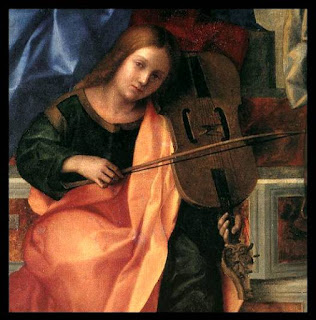China, India, and Mongolia might have had bowed strings in ancient times, but as far as is known, Rome, Greece, and Egypt did not.
The first evidence of bowed strings in Europe appears in the late medieval times, apparently from Arabic sources entering through Spain.
 | ||||||
| One of earliest European images of bowed string instruments. This is an illumination from a manuscript circa 950 A.D |
We see the earliest development of guitar like and fiddle like instruments occurring in Spain, and then somewhat latter continuing in Italy. Today, all instruments with strings, neck, and fingerboard are classed as 'lutes'. Both guitar makers and violin makers are today called Luthiers. The word lute supposedly traces back to Arabic sources as al-'ud.
By the late renaissance, we see wide experimentation with different configurations and combinations of features in bowed instruments.
Here in an Italian painting around 1510:
This instrument has frets and many pegs so it can be strung for chordal playing as a viol. Note the curved top, and the artist's placement of the bridge below the sound holes. This instrument has a waist to facilitate bowing. But unlike the later violins, there is no recurve in the sides as they approach the corners. The pegs are let into the sides of a pegbox similar to later violins and viols. The pegbox terminates in an animal head, but still has the basically curved and knobby structure of later scroll styles.
Here are a nearly identical pair of vihuela of the hand and vihuela of the bow from the same painting in Valencia, Spain ca 1510:
Again from Valencia, Spain ca 1480, we have one of the earliest pictures of a viol like stringing. This also shows some round venting holes, filled in with rosette filigree work.
At the Vatican, painted somewhere between 1438 and 1498, we see an instrument somewhat approaching a violin, but with a flat top like a vihuela. Notice that on this instrument the top overlaps its edges over the sides, like in the modern violin family.
In this panel from the Isenheim Altarpiece painted by Grunewald, circa 1515, we see a shape with an extremely high and narrow waist.
Here is a painting attributed to Antonio Solari (1460 - 1524). The painting shows an instrument in very precise detail, played on the shoulder and in many respects approaching the basic form of the violin family. And yet this is still very much also a vihuela.
Besides the many variations of vihuela shapes and sizes we see leading up to the guitar, viol and violin families, we also see many other kinds of body shapes and strings. The artist appears to be showing a very gentle curvature to the top.
The rebec has a solid form pear shaped back, usually without separate sides.
The lira da braccio has the vihuela type shape, but strung for chordal playing and with extra sympathetic strings. These typically have the spade shaped head to hold the many pegs needed.
Here the painter Lorenzo Costa from Ferrara Italy paints a small violetta on the table below the musicians. This little instrument again shows features from the older vihuela type instruments, but also experiments with features that will survive into the violin family.
Costa was associated with Isabella d'Este. Interestingly, in a letter, d'Este called for the creation of a choir of stringed instruments as the most perfect vehicle for harmony.
Within her lifetime, and less than 150 miles from the court of Ferrara, her call for a choir of strings was realized in Andrea Amati's work establishing the violin family we now know and love.












No comments:
Post a Comment